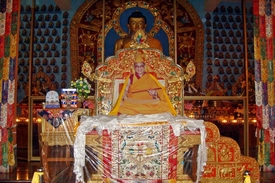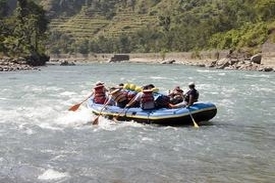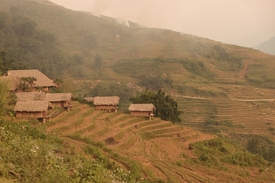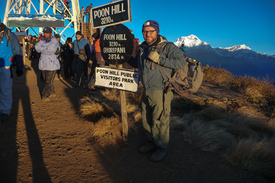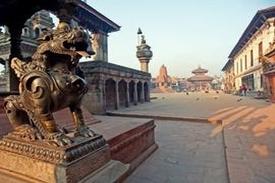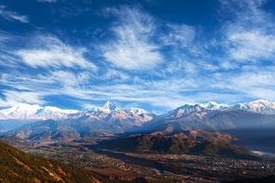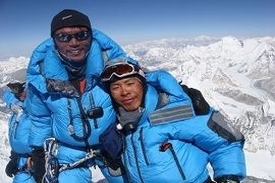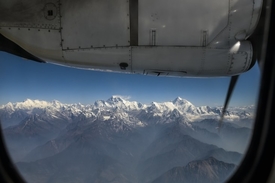Draped along the spine of the Himalayas, Nepal is a land of sublime scenery, time-worn temples, and some of the best hiking trails on earth. It is rich in scenic splendour and cultural treasures and has long exerted a pull on the imagination of travellers from near and far.
It is the kind of country that lingers in your dreams long after you leave it. This is why so many travellers are drawn back to Nepal, armed the second time round with a greater appreciation of its natural and cultural complexity, a stout pair of walking boots and a desire for sculpted calf muscles.
This program and time table mentioned are just for the guidelines, we can tailor it once we know the individual thoughts.
Day 01 Arrive Kathmandu
Welcome to Nepal! It is a panoramic thrill flying into Kathmandu on a clear day. The views of snow-capped mountain peaks sprawling down below you are almost ecstatic, beginning a whole chain of memorable experiences that stay with you for a long, long time. A representative and driver from our company will meet you at the airport and escort you hotel.
No program on This day and welcome diner in the evening.
Day 02 Kathmandu: MT. Flight & Sightseeing: Pashupatinath & Patan
Early in the morning wake up and drive to Airport for the mount flight.
One of the must-see landmarks of Nepal is, of course, the highest peak in the world – Mount Everest. An awe-stricken silence comes close to matching the experience of a mountain flight. For one hour, you’ll fly over the Eastern Himalayan Ranges of Nepal where some of the highest peaks in the world including Mt. Everest lie for a surreal feeling as you come face to face with the world’s tallest and most enigmatic of Mountains. Even those visitors who like the rigors of a trek won’t miss the opportunity to “conquer” the mountains in one stunning swoop.
After breakfast at the hotel commence the sightseeing tour of Pashupatinath.
Pashupati Temple stands in the center of the town of Deopatan, in the middle of an open courtyard. It is a square, two-tiered pagoda temple built on a single-tier plinth, and it stands 23.6 meters above the ground. Richly ornamented gilt and silver-plated doors are on all sides.
On both sides of each door are niches of various sizes containing gold-painted images of guardian deities. Inside the temple itself is a narrow ambulatory around the sanctum. The sanctum contains a one-meter high linga with four faces (chaturmukha) representing Pashupati, as well as images of Vishnu, Surya, Devi and Ganesh. The priests of Pashaputinath are called Bhattas and the chief priest is called Mool Bhatt or Raval. The chief priest is answerable only to the King of Nepal and reports to him on temple matters on a periodic basis. The struts under the roofs, dating from the late 17th century, are decorated with wood carvings of members of Shiva’s family such as Parvati, Ganesh, Kumar or the Yoginis, as well as Hanuman, Rama, Sita, Lakshman and other gods and goddesses from the Ramayana.
Pashaputi Temple’s extensive grounds include many other old and important temples, shrines and statues. South of the temple, for instance, is Chadeshvar, an inscribed Licchavi linga from the 7th century, and north of the temple is a 9th-century temple of Brahma. On the south side of Pashupati temple is the Dharmashila, a stone where sacred oaths are taken, and pillars with statues of various Shah Kings.
The Bagmati River, which runs next to Pashaputinath Temple, has highly sacred properties. Thus the banks are lined with many ghats (bathing spots) for use by pilgrims. Renovating or furnishing these sites has always been regarded as meritorious.
Arya Ghat, dating from the early 1900s, is of special importance because it is the only place where lustral water for Pashupatinath Temple can be obtained and it is where members of the royal family are cremated. The main cremation site is Bhasmeshvar Ghat, which is the most-used cremation site in the Kathmandu Valley. The preferred bathing spot for women is the Gauri Ghat, to the north.
The Patan Museum Cafe has been crafted to complement the superb period ambience achieved by the architects and builders of the Museum itself. Located in the inner courtyard of the Keshav Narayan Chowk in Patan Durbar, the cafe will offer a mix of traditional and western delicacies and light meals in a setting unparalleled in the Kathmandu valley.
Patan city: Located about 5 km south of Kathmandu, Patan is one of 3 royal cities in the valley. A destination for connoisseurs of fine arts, Patan is filled with wood and stone carvings, metal statues, ornate architecture, including dozens of Buddhist and Hindu temples, and over 1200 monuments.
Patan is believed to have been built in the third century B.C. by the Kirat dynasty later expanded and enriched by the Licchavi and the Malla rulers in the medieval period. Patan Durbar Square, like its counterpart in Kathmandu, is an enchanting mélange of palace buildings, artistic courtyards and graceful pagoda temples. The former Royal palace complex is the centre of Patan’s religious and social life, and houses a beautiful museum.
Dinner and overnight at hotel.
Day 03 Drive to Chitwan, En-route Rafting at Trishuli River
After breakfast drive to trishuli and after rafting drive to chitwan
Chitwan National Park is a large and beautiful nature reserve occupying 932 sq. km. of land inhabitant of endangered royal Bengal tiger and the one-horned Indian rhino. Chitwan National Park was protected since the 19th century as a hunting reserve for Nepali royals and foreign aristocrats. In a famous hunting expedition, King George V and his son Edward VIII managed to slaughter 39 tigers and 18 rhinos in a single blood-soaked afternoon. Unfortunately, habitat loss and poachers continue to decimate the number of tigers and rhinos. Today, there are less than 80 tigers and 500 rhinos left in the Park. There are more than 50 species of mammals in Chitwan including monkeys, tigers, leopards, sloth bears, wild boar, hyenas, deer, elephants and rhinos. There are also 450 different species of birds and 67 species of butterflies. The main attraction of Chitwan is the Elephant Safari. It is a unique experience to explore the jungle on the back of a trained elephant. While you are not likely to see the Bengal tiger, you should be able to see the Indian rhino and enjoy one of the nicest nature reserves of the Indian sub-continent. Watch out for branches – particularly if you are sitting behind other passengers.
Seated high on the back of an elephant, gain a unique viewpoint of the Chitwan jungle. As an experienced mahout tracks animals through the dense jungle growth as you sit back on a howdah, you can imagine yourself being a Rajah or Rani going on a shooting trip (with cameras of course!) in the days of yore. An elephant safari allows you to go places that would be impossible to get to by foot or Jeep and get up close to the wild animals of the jungle that are normally wary, but at home with a fellow creature of the jungle
Spending some time on a nice observation tower in the jungle is another amazing experience.
A melodious tribal dance performed by men and women with rhyme or drums and the clashing of sticks embodies and projects how to keep away the rhino and other wild animals from the human habitat and their farming land. You can enjoy your evening after dinner and watch the Tharu Stick Dance. We will arrange dance for your enjoyment adjacent to our Restaurant.
Dinner and overnight at the Lodge.
Day 04 Jungle Activities / Visit Local School & Village
After breakfast Bird watching in Community Jungle
Chitwan is an ornithologist’s delight and a must for any serious twitchier, as more than 450 species of exotic birds such as the Oriental Pied Hornbill, Paradise Flycatcher, and Lesser Adjutant Stork congregate at this biological hotspot of Asia. Our experienced guides will take you to select spots ideal for birding, where you can observe a breathtaking diversity of these beautiful feathered creatures.
0830 hours: Breakfast.
0930 hours: Dugout Canoe ride
Floating down to Rapti River by dugout canoe is the best way to discover the habitat of crocodiles on the bank of the river. It is also a relaxing and better way to watch the different kind of birds and wildlife species when they come to the bank of the river to drink water.
1100 hours: Elephant Breeding Center
Was established in 1985 at Royal Chitwan National Park (RCNP) and is the only EBC in Nepal. At the Elephant Breeding Program, 4km west of Sauraha, elephants are breed and trained. The best time to visit is in the afternoon when the elephants are fed. The Elephant Breeding Centre of Sauraha with great tourist attraction is said to be one of the only 3 such centers in the world.
Elephant skin is extremely sensitive to sunburn and insect bites; they roll in dust and mud and throw dust on their backs to help protect their skin. This was one of such moments when this restless young Elephant tried to get rid of insect.
1230 hours: Lunch at the resort.
1330 hours: Local school visit
Situated in the serene location of Chitwan district, SOS Hermann Gmeiner School Bharatpur was established in 2004, with more than five hundred students and 45 staff at present. Nursery to Grade Five were the classes introduced in the first year, however, in the span of three years, the year 2007 came up with full-fledged classes up to Grade Ten. The school first appeared in the SLC examination in 2008 and started higher secondary level in Science stream in the very year with 38 students. In a very short span of time, with the efforts of dedicated, devoted and determined teachers, the school achieved fabulous result in the SLC examination glorifying its name as the best and one of the most reputed schools in the district. It was also awarded ‘The Best School’ by the District Education Office, Chitwan due to its excellent SLC result in 2008.
1530 hours: Tharu village visit
Tharu are indigenous people of the Terai. They have a distinct architectural style, building solely of the natural materials found in the area; straw, wood and mud. Even though by now almost all Tharus are Hindus some elements of their tribal religion can still be found. The villages are often peaceful, non-industrial havens, with the inhabitants engaged in a yearly agricultural circle.
1700 hours: Drive back to lodge.
2000 hours: Dinner and overnight at the Lodge
Day 05 Drive to Pokhara
0700 hours: After breakfast at the lodge drive to Pokhara takes 05/06 hours under normal road conditioned.
Pokhara is a remarkable place of natural beauty. At an elevation lower than that of Kathmandu, it has much more tropical feel to it; a fact well appreciated by the beautiful diverse flowers that prosper in this environment. The enchanting city with a population of around 95,000 has several beautiful lakes and offers stunning panaromic views of Himalayan peaks. The valleys surrounding Pokhara is home to thick forest, gushing rivers, emerald lakes and of course, the views of world famous Himalayas. The serenity of the lakes and the magnificence of the Himalayas rising behind them create an ambience of peace and magic.
Pokhara is the most popular destination for visitors to Nepal. The city is also known as the center of adventure. There is little in its past by way of neither history nor culture impact and the only important role that the old Pokhara played was that it was along the route of trade between India and Tibet. Today it is one of the fastest developing cities of Nepal, mainly due to tourism.
The natural beauty of its lakeside location and its proximity to the mountains has made it the natural choice for trekkers and adventures. Pokhara is also the base for some of most famous trekking circuits of Nepal. By itself surrounding area provides ample scope for short walk and day trips, suitable for children or weary trekkers, which can be made around the valley.
1200/1300 hours: Arrive in Pokhara followed by lunch at the hotel.
1400 hours: Relax at the hotel.
1630 hours: Boating at Lake Phewa.
Spend a quiet time boating in the ultimate lake where the reflections of Mount Annapurna and Macchapuchare range falls. You will also see a variety of fishes while boating. An island temple is located at the middle of the lake. Thick forest lies on the adjoining southern slopes of the lake. It’s hard to escape the draw of Phewa Lake and any visitor with even a few spare minutes should endeavour to take a boat out on the water to fully experience the wonderful views of the reflected mountains.
1800 Hours: Dinner at Hungry Eye Restaurant
Hungry Eye restaurant is an informal, legendary, award winning an international all day dining restaurant which serves rich Continental, American and Indian buffet breakfast featuring live cooking station. Recently renovated, fresh and contemporary, the restaurant is perfect for informal dining with a range of tempting choices and hosting some of the most popular theme evenings in Pokhara. The A la carte menu offers 5 different cuisines in a fine dining concept, all in the same venue with wide range of world finest wine and spirit. The menu ranges Nepalese and Chinese to Indian and Italian to continental, all prepared in its action kitchens, the restaurant consistently delivers a truly memorable dining experience.
Overnight at hotel.
Day 06 Sightseeing / Drive to Bagnas Lake & Trek to Thulakot
0630 hours: Wake up call.
0700 hours: Breakfast at the hotel.
0800 hours: After breakfast at the hotel commence the sightseeing tour of Pokhara city.
Devi’s fall: Locally known as Patale Chhango (Hell’s fall), Devi’s fall is an amazing waterfall lying about 2 km south-west of Pokhara airport on the highway to Tansen. It was named after Devi, a Swiss lady who was swept away when the floodgates were accidently opened, never to be seen again.
Tibetan Villages: Tibetan Villages, Tashiling in the south and Tashil Palkhel in the north of Pokhara Valley are the two Tibetan villages that are inhabited by the Tibetan people who keep themselves busy by producing and trading woollen carpets and other handicrafts.
Annapurna Museum: Also known as the Natural History Museum, it is located at Prithivi Narayan Campus east of the old bazaar. Managed by the Annapurna Conservation Area Project (ACAP), the museum has an exceptional collection of butterflies, insects, birds, and models of wildlife as well as samples of various precious and semi-precious stones and volcanic rocks.
OR go for Ultra light aircraft [optional]…
Ultra light aircraft was introduced in Nepal in 1996 and has been offering tours in and around Pokhara valley from Pokhara airport. Because of the proximity of the mountains and the scenic lake, Pokhara is the suitable place for this activity as they share airspace with Himalayan griffin vultures, eagles, kites and float over villages, monasteries, temples, lakes and jungle, with a fantastic view of the majestic Himalayas. For those who wish they could fly like birds. The flights are operated in the morning from sunrise till 11am and from 3pm till sunset in the months from September till June. It flies at the speed of 50-130kms/hr depending on wind direction and speed. It can even take off and land in a field or on a dirt road. The aircraft seats two; a passenger and a pilot only.
1230 hours: Lunch at local restaurant.
1330 hours: Drive to Begnas Lake. Start hike upto Thulakot (3-4 hours).
Begnas Lake is the second largest lake of Pokhara and is set amidst a hillock loaded with greenery. This is the best place if one wants to enjoy peaceful view of the beautiful mountains, valley and scenery. Tourists can indulge in boating and fishing here.
Thulakot is a tiny village located in the vicinity of Pokhara which falls en route whilst the Royal Trek- trek done by Prince Charles, Prince of Wales, thirty years ago. From Pokhara one has to drive to Begnas Lake which takes around one and half hours and from here there is an uphill walk of 2-3 hours of before you finally reach Thulakot. The inhabitants of the village are mostly farmers engaged in agriculture and animal herding.
Traversing through various geographical terrains, villages, rhododendron forest, high alpine meadows resting below the soaring peaks of Annapurna region this trek unveils the picturesque beauty of Nepal. We can also hear the beautiful chirping sounds of the birds all along the trekking route. Once you reach Thulakot the scenery seen from this hilltop is divine as one can see the snow -capped mountain range in the north and Begnas Lake, Maidi Lake and the Pokhara City on the other side. There is the lovely sunrise with the spectacular views of the famous mid-west Himalayan mountains- Annapurna range, Machhapuchchhre, Dhaulagiri and Manaslu that cannot be missed on clear day. Many villages of the hilly region like Khilang, Siklesh and villages of Lamjung also can be seen from this region.
This trek apart from the picturesque scenery is a rewarding experience to interact with the local villagers from whom one can learn of their customs and traditions of these people. It certainly would be recommendable place as a nice spot for people who would want to escape from the maddening chaos of Pokhara City for a day.
Good footwear is essential. Proper trekking shoes with ankle support would be ideal. However, this is not a difficult hike; normal walking or running shoes will be all right. We have our own bathe tent where hot water, towel and soap are ready. We have modern flush toilets and will be erected at the campsite.
1600 hours: Arrive at campsite followed by welcome drinks. Check into tents and change clothes for the evening. Free time for writing postcards, diaries, resting or picture-taking surrounding Mountains.
1630 hours: Hot Tea or Chocolate served.
Evening local folk song and dance by villagers with campfire.
“Dohori” – a Nepali folk song that covers a vast array of musical styles, but is most commonly used to refer to a narrative song that uses traditional melodies to speak on a particular topic. Often these songs address social issues expressing popular opinions.
2100 hours: Dinner and overnight at tent.
Day 07 Drive to Pokhara & Fly back to Kathmandu
0500 hours: Witness a beautiful sunrise view over the Himalayas.
0600 hours: Breakfast
0830 hours: After having plenty breakfast at the camp we hike down to Buddhi Bazzar on dirt road. In this short hike you can witness mixed local inhabitants of Bahun, Chhetri, Tamang etc.
1030 hours: Our vehicle is ready to pick you up from Buddhi Bazzar to Pokhara domestic airport and will take 25 minutes under normal road condition.
1055 hours: After reaching at Pokhara domestic airport we fly back to Kathmandu by schedule flight.
1125 hours: Board the domestic flight.
1155 hours: Arrive Kathmandu transfer to hotel.
1215 hours: At the hotel
1245 hours: Have lunch at the hotel.
1345 hours: Drive to Bhaktapur for sightseeing tour.
Also known as city of devotees, Bhaktapur is the home of medieval art and architecture. Lying 14 kilometres/9 miles east of Kathmandu City, this place was founded in the 9th Century and is shaped like a conch shell. The city is at the height of 4,600 ft. above sea level. In Bhadgaon, you will visit the Durbar Square with the Palace of 55 windows built by King Bhupatindra Malla. The famous five-storied Nyatapol temple on the terraces of which stands a pair of figures – two goddesses, two strong men, two elephants, two lions and two griffins is the tallest temple in the valley and was also built by King Bhupatindra Malla. It is one of the best examples of Pagoda styled temples.
1700 hours: Bhaktapur Cultural Program (Newari Cultural) & Dinner.
Aarati Dance
It is the process of worship by offering oil lamps to the deities. Usually it is a process used for gods and goddesses and holy beings. As our culture considers guests to be a form of god and goddesses, we present this dance constituting the Aarati in which Newari girls in their traditional attires will present it in the hope the peace and prosperity may shine down on us.
Jyapu-Jyapuni Dance
“Jyapu” is the word used to address males of the Newari farmer’s community and “Jyapuni” to address females. This dance depicts the legendary love story of a Jyapu and a Jyapuni. The story is a popular and touching as the story Romeo and Juliet and the Rajamati, the lead female character is a very popular among Newar’s of all age groups.
Dhimen Pyakhan
Newar’s celebrated every significant moment with great vigor. Whenever there is something to celebrate and enjoy, they gather and start dancing to the beats of the traditional drum, Dhimen.Dhimen beats are loud and make people jump to their feet. If interested, we would like our guests to join in the dance. One has the freedom of moving in anyway with the beats. With some alcohol, the joy of the dance is enhanced for sure.
Bhairav Dance
Bhaktapur is also known as the “capital of cultural dances and cultural music”. Among many traditional cultural dances of Bhaktapur, mask dances are one of the most popular. And among these mask dances the Bhairav Pyakhan or Bhairav Danceis the most popular one.
Almost all of the traditional dances follow some kind of legend and traditional beliefs and same with the Bhairav Pyakhan. The legend behind the Bhairav Dance goes as follows. Hundreds of years back, the evil forces and beings, Bhoot, Pisach andRakshasa, started to dominate the world. The evil beings, Daityas started destroying humans and the natural balance was threatened. Then the god Bhairava came down to earth with other divine bodies to destroy those evil beings for restoring peace and to maintain the natural balance.
Astamatrika Dance:
To protect the country from evilsprits and different kinds of disaster like fire, flood, hurricane, earthquake and drought, the people of the Newar community all over the country used to worship different gods and goddesses to please them. In this dance, eight Matrika Gan dancers show dance such as Bramhayani Mahashwari, Kumari, Baishnavi, Barahi , Indrayani, Mahakaliand Mahalacmi; Ashtamatike Gan is taken to security Personal of the country.
Bhasmasur Dance:
Once, Mahadev, known as god of gods, gave a boon to Bhasmasur. Receiving the boon he became powerful and won the kingdom of Devas ruled by Indra. If he puts his hand over anybody’s head this person will be changed into ashes immediately. Being powerful, Bhasmasurbecame proud and cruel. He wanted to make his own wife the wife of Mahadev, Paravati. On the request of Devas to solve their problem, Bishnu, one the Tridev, changed himself into a most beautiful woman called Mohiniand proposed Bhasmasur to dance with her. Accepting that,Bhasmasur transformed into ashes putting his own hand over his head. Since the Malla period in Thimi, the same dance is performed among the people every year from Gai Jatra (Con Festival) to Indra Jatra.
2000 hours: Theme dinner at Bhaktapur night.
2200 hours: Drive back to Kathmandu.
2230 hours: Overnight at hotel.
Day 08 Depart Kathmandu
Breakfast at the hotel.
We ensure that you will leave Kathmandu with cherishing memory and an experience of a lifetime. Our representative will drive you to the airport in time for your flight back home.
| City | Night (s) | 5* Standard | 5* Deluxe |
| Kathmandu | 02 | Hyatt Regency | Crown Plaza Soaltee |
| Chitwan | 02 | Meghauli Serai | Barahi Jungle Lodge |
| Pokhara | 01 | Shangri La Resort | Pokhara Grande |
| Thulakot | 01 | Camping | Camping |
| Kathmandu | 01 | Hyatt Regency | Crown Plaza Soaltee |
Inclusions
– Welcome with fresh flower garlands.
– Meet assist at the airport and hotels.
– 07 nights accommodation as per the program in the hotels / resorts / Camps of your choice.
– Daily breakfast, lunch and dinners.
– Alcohol package during the lunch and dinner every day.
– Welcome Gala Dinner and Farewell Gala Dinner.
– Theme dinners as per your choice.
– Cultural Folk Dance shows with live music.
– All transfers, sightseeing, excursions by private AC vehicle as per the program.
– Accompanying English / German / French / Italian / Spanish / Chinese / Arabic / Korean / Hebrew / Polish / Russian speaking escort cum guide from arrival till departure.
– Entrance fees to the monuments as per the program.
– All taxes.
Activities
– Turban & Saree tying lesson.
– Masala Chai Demonstration.
– Local Cuisine live demonstration.
– Cultural dance show.
– 01 Yoga class.
– 01 dinner of Indian thali.
– Hot Air Balloon Ride.
– Elephant Safari.
– Magic Show.
– Henna Painting.
– Stand-up Comedian.
– Tuk Tuk / Rickshaw Ride.
– Dress in local attire with dinner.
– River Rafting.
– Boat Cruising.
– Hot Stone Bath.
– Astrology & Palm Reading.
– Live Theatre Performance
Branding
– Logo branding on Vehicles.
– Color and logo branding Merchandise.
– Departure gifts with company’s branding.
– Tips.
– Visa (if any).
– International Air Fare.
– Travel & health insurance.
– Personal expenses and drinks.
– Accommodation in good hotels.
– Check-in / out time is 12 noon at most of the hotels.
– Extension to other places is also possible with a minimal extra cost.
– A visa is required and must be obtained prior to your departure from your Country.
– If quoted hotel is not available, we will provide one of a similar category and standard.
– Small deviations in the tour program are sometimes necessary, depending on weather, road conditions, flight schedules and room availability.
– In case the government changes presently applicable taxes, increase in airlines prices, fuel surcharge our rates will need to be adjusted accordingly.
– In Asia, there is no relevance between the distance and time of traveling, as it depends upon the condition of the roads and congestion of the traffic.
– While every effort will be made to maintain the itinerary, in view of local strikes etc that are beyond our control all schedule and itineraries are subject to last moment changes.
– Clients must be fully insured, as the company cannot accept liability for loss or damage to client’s property, medical emergencies or any other loss suffered by them whilst on tour.
– In Case of issuing Domestic or International air tickets, SGV is not responsible for any refund if the flight is delayed or cancelled, as it is the responsibility of airline.




